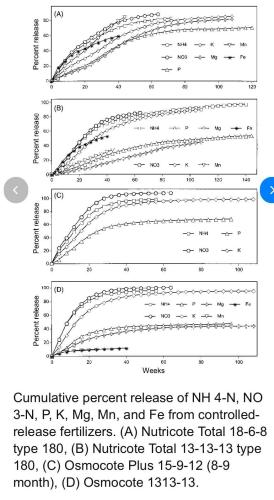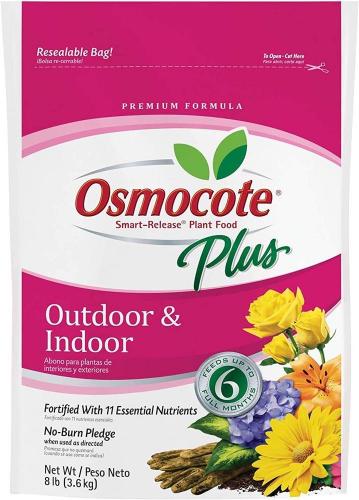Hi Jim,
@Moonshadow
The NPK content of 15-9-12 in this Osmocote Plus 6-month release is probably OK for outdoor potted plants for the summer.
I wouldn't use it in my garden.
Outdoors in soil, and indoors in permanent pots, I would expect an eventual buildup of phosphorus (P). This can stunt plant growth.
A ratio of 3:1:2 N:P:K has been found generally suitable for most types of plants. The original 18:6:12 Osmocote was an appropriate ratio. The 15-9-12 would be better if 15-5-8 but *only* if the soil lacked phosphorus.
If a soil needs fertilizer the ratio is not as important as the rate. The more that's applied of this that's applied, the more phosphorus that's being added that might not get used. Excess nitrogen and potassium are more likely to runoff or to seep deep into the soil. Phosphorus is often called "immobile" because it doesn't seep down rapidly. It resists dissolving.
In general, phosphorus should not be applied to outdoor soils without a soil test. Phosphorus has been removed from most lawn fertilizers now because of repeated applications causing buildup. This has contributed to pollution caused by phosphorus runoff.
There are many different formulations and programmed release rates of both Nutricote and Osmocote. It's not possible to talk about most differences between them without specifying the exact product.
One noticeable difference - Nutricote does not have a plastic prill encasing it. No little round balls left in the soil.
Gina
@Gina1960, The plastic prills may be why the mall gardeners put the Osmocote in the bottom of the holes- to avoid having little balls on the surface that children or animals might pick up. Usually they are placed on top for the dissolving fertilizer to sink to the roots, or mixed in the soil for root contact.
When similar products are compared, Nutricote tends to be released more slowly and more linearly in response to temperature than Osmocote. Nutricote's release is not just controlled by moisture though. I've posted an article below about release rates including 13-13-13 (and 2 other) products of each. I use a Nutricote 18-6-12 with minor elements on potted plants in soilless potting mixes.
In my garden, last year I started using the new Scotts Ultrafeed 44-0-5 NPK 6-month release. It has one of the most linear release rates in relation to temperature that I've seen. It's a mix of white and aqua uniform pellets. Easy to see while applying. They dissolve completely with no sign after a rain.
Is it "high" in Nitrogen at 44%? Yes. That just means I'm getting more for my money given the slow feeding rate. Most of the growth response of plants in average fertile silt-clay-loam soils is to added nitrogen rather than the other elements. Remember that how "high" it is actually depends on how much you apply - the rate. It takes some calculating to get to the rate you want.
My calculations came to 2 tsp Ultrafeed per square foot to supply 150 lbs N/acre. That's comparable to rates applied to lawns. It works well for daylilies. I use 1 tablespoon per clump up to about 2 feet across. 1 tsp for new plants sprinkled over a 1' circle around the plant. At the current price of $35/20 lbs at Home Depot, I calculated $0.11 per tablespoon. But TBH most of our 2000+ daylilies don't get fertilized at all and grow very well without it.
Pat
https://www.researchgate.net/f...

Edit: I just realized that these graphs only show the release rates at a single temperature. The study was conducted in a lab at a "constant 23°C", which is 73-74°F. Soil temperatures could be either lower or higher than that.


